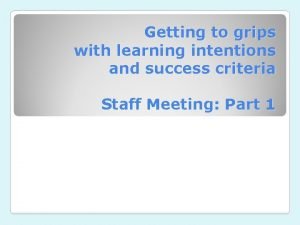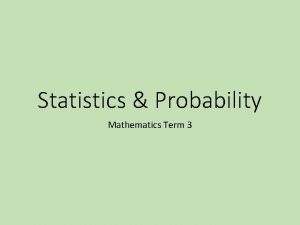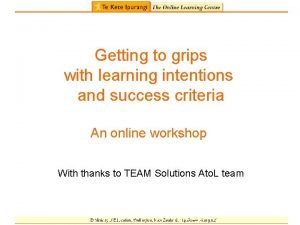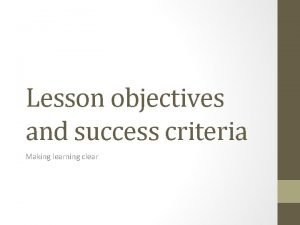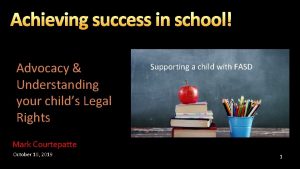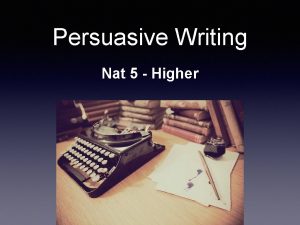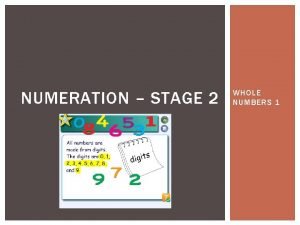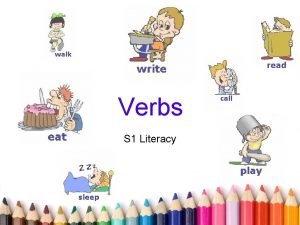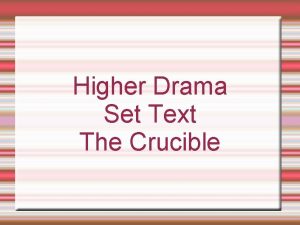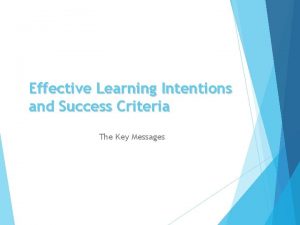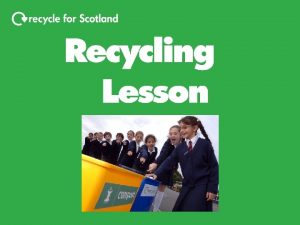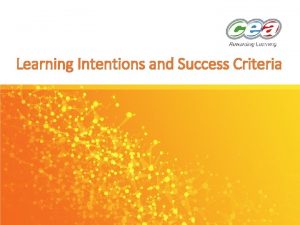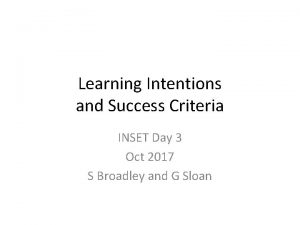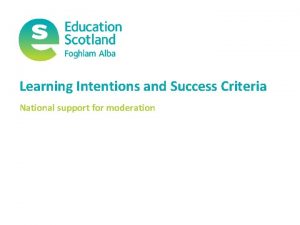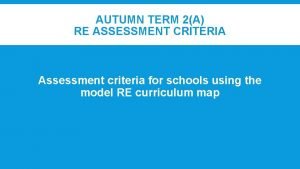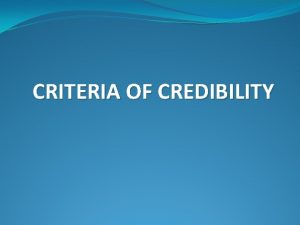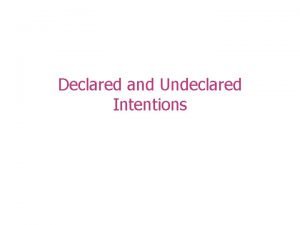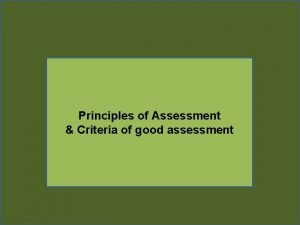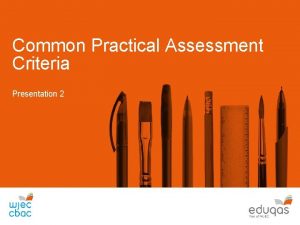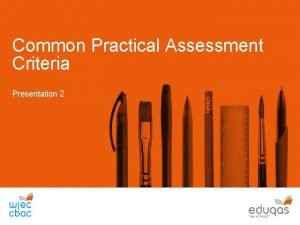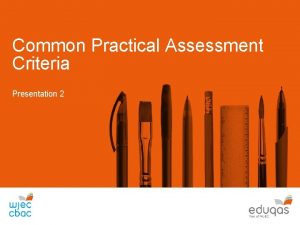Assessment for learning Learning Intentions Success Criteria Learning




















- Slides: 20

Assessment for learning Learning Intentions & Success Criteria

Learning Intention Today we are learning to understand what learning intentions and success criteria look like in the classroom. Success criteria I can: • identify effective learning intentions • separate learning intentions from their context • construct learning intentions and success criteria on my own

Why use Learning Intentions? Using learning intentions helps students develop a picture of what is expected of them from the learning. “Many pupils do not have such a picture and appear to have become accustomed to receiving classroom teaching as an arbitrary sequence of exercises with no overarching rationale… When pupils do acquire such overview, they then become more committed and more effective as learners: their own assessments become an object of discussion with their teachers and with one another…” Black & Wiliam (1998) P 10

What Is a Learning Intention? ‘A learning intention describes what pupils should know, understand or be able to do by the end of the lesson or series of lessons. ’ (Learning Unlimited, 2004) Learning Intentions • Identify new learning • Focus on transferable skills

Sharing Learning Intentions 1. 2. 3. 4. 5. Identify what pupils will be learning (We are learning to…). Explain the reason for the learning (This is because…). Share (and sometimes negotiate) the learning and the reason with pupils at the beginning of the lesson or activity. Present these in language that pupils can understand. Revisit the learning intention throughout the activity/lesson.

Learning intentions may be written like this: • • We are learning to … To be able to … To understand / explain / discuss etc Today we will be able to …

What is the Learning? Rather than frame learning intentions in terms of what a pupil will be doing, we need to define the learning. The learning can be expressed in terms of: Knowledge Understanding Skills * Focus on transferable skills when possible

Defining the Learning Intention • We are learning to… - work effectively in groups. - use evidence to draw conclusions. - identify odd and even numbers.

Separating Learning Intention from context • Activity: What are we doing? - Write a description of your best friend. • Learning Intention: What are we learning? - To write an effective characterisation. • Context: Vehicle for the learning - Friendship

Getting the Learning Intentions Right! Activity Learning Intention Context Give a speech for or against smoking To present a point of view in a persuasive way Speech about smoking Draw a bar chart to show pupils in our class come to school To present information graphically Bar chart on types of transport used to get to school Work effectively in a group to design a leaflet to promote healthy eating To be able to work effectively in a group Healthy eating leaflet

Tips: Using Learning Intentions Effectively • • • Start small. Separate the learning intention from the activity instructions. Tell pupils why they are learning it. Use child-friendly language (and/or ensure children have the language of learning). Make it visible (display). Allow time for discussion with pupils.

Success Criteria Learning Intentions What? and Why? Success Criteria ‘How to recognise success’

What Are Success Criteria? ‘… success criteria summarise the key steps or ingredients the student needs in order to fulfill the learning intention – the main things to do, include or focus on. ’ - Shirley Clarke

Why Are Success Criteria Important? • • Improve understanding Empower pupils Encourage independent learning Enable accurate feedback

Effective Success Criteria… • • • are linked to the learning intention; are specific to an activity; are discussed and agreed with pupils prior to undertaking the activity; provide a scaffold and focus for pupils while engaged in the activity; and are used as the basis for feedback and peer-/self-assessment.

Effective Success Criteria cont. Learning Intention: We are learning to write a narrative. Activity (context) : Write a ghost story. I will be successful if: • people enjoy reading my story; and • it frightens them. • set the scene in the opening paragraph; • build up tension/suspense; • use spooky adjectives and powerful verbs; and • end with a cliffhanger. Which set is more helpful to students? When creating the success criteria, it is important to focus on process and characteristics rather than the final effect.

Additional Examples We are learning to… present an argument. Remember to… • include opening and closing • give reasons for and against • use evidence to support • use language to persuade We are learning to… calculate the passing of time in 5 -minute intervals. Remember to… statements • • count from the minute hand stop where the minute hand finishes count in fives go clockwise

Summary To take more responsibility for their own learning, pupils need to know: • what they are going to learn; • how they will recognise when they have succeeded; and • why they should learn it in the first place.

Using Learning Intentions and Success Criteria: • creates more self-motivated pupils; • empowers pupils to become independent learners; • improves understanding; and • can help focus feedback. This isn’t all new • but we need to be more systematic about using these approaches in our classrooms.

Learning Intention Today we are learning to understand what learning intentions and success criteria look like in the classroom. Success criteria I can: • identify effective learning intentions • separate learning intentions from their context • construct learning intentions and success criteria on my own
 Learning intentions examples
Learning intentions examples Learning intentions and success criteria examples
Learning intentions and success criteria examples Learning intentions and success criteria for mathematics
Learning intentions and success criteria for mathematics Example learning intentions
Example learning intentions List of criteria example
List of criteria example Your child's success or lack of success
Your child's success or lack of success Your child's success or lack of success
Your child's success or lack of success Jabberwocky alliteration
Jabberwocky alliteration Persuasive writing learning intentions
Persuasive writing learning intentions 640 739 in expanded form
640 739 in expanded form Poetry learning intentions
Poetry learning intentions Objectives of fractions
Objectives of fractions Half turn symmetry
Half turn symmetry Learning intention verbs
Learning intention verbs Poetry learning intentions
Poetry learning intentions Poetry learning intentions
Poetry learning intentions Peacock poem
Peacock poem Creative writing learning intentions
Creative writing learning intentions Ocean acrostic poem
Ocean acrostic poem Drama learning intentions
Drama learning intentions The meaning of advent worksheet
The meaning of advent worksheet
